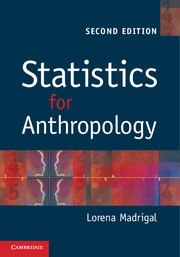Book contents
- Frontmatter
- Contents
- List of partial statistical tables
- Preface
- 1 Introduction to statistics and simple descriptive statistics
- 2 The first step in data analysis
- 3 Probability and statistics
- 4 Hypothesis testing and estimation
- 5 The difference between two means
- 6 The analysis of variance (ANOVA)
- 7 Non-parametric tests for the comparison of samples
- 8 The analysis of frequencies
- 9 Correlation analysis
- 10 Simple linear regression
- 11 Advanced topics in regression analysis
- References
- Index
3 - Probability and statistics
Published online by Cambridge University Press: 05 June 2012
- Frontmatter
- Contents
- List of partial statistical tables
- Preface
- 1 Introduction to statistics and simple descriptive statistics
- 2 The first step in data analysis
- 3 Probability and statistics
- 4 Hypothesis testing and estimation
- 5 The difference between two means
- 6 The analysis of variance (ANOVA)
- 7 Non-parametric tests for the comparison of samples
- 8 The analysis of frequencies
- 9 Correlation analysis
- 10 Simple linear regression
- 11 Advanced topics in regression analysis
- References
- Index
Summary
In this chapter we lay down the probability foundation for the rest of the book. All statistical tests rely on some aspects of probability, whether the test is working with qualitative data such as kinship titles or continuous data such as milliliters. The rules of probability are necessary for our understanding of statistical tests, but they are also necessary for our understanding of how scientific statements should be expressed, and more broadly, how science works. As I noted in chapter 1, science works with hypotheses which are submitted to tests and are either accepted or rejected but not proven. As we will see later, when we reject a hypothesis we reject it knowing full well that we could be committing an error and what the probability is that we are making an error. Therefore, the field of probability is essential to science-making because all predictions about the occurrences of events or explanations of events with hypotheses are qualified by probability statements. According to Fisher (1993), scientific inferences involving uncertainty are accompanied by the rigorous specification of the nature and extent of the uncertainty by which they are qualified. Since probability rules are fundamental to all scientific statements and to hypothesis testing, this chapter is extremely important to an understanding of statistical reasoning and hypothesis testing.
Many of you were exposed to the rules of probability for the first time in Elementary School. My students have told me that they learned the rules of probability in terms of blue and red marbles and that they forgot everything else about them except how pointless the marbles seemed at the time. Marbles may not be the best example to use, and I will try to focus on anthropological examples. However, the blue and red marbles examples remind us of the broad purpose behind learning probability in a statistics class. The purpose is for the student to understand that there are ways of predicting the likelihood that events or outcomes will occur.
- Type
- Chapter
- Information
- Statistics for Anthropology , pp. 42 - 82Publisher: Cambridge University PressPrint publication year: 2012

